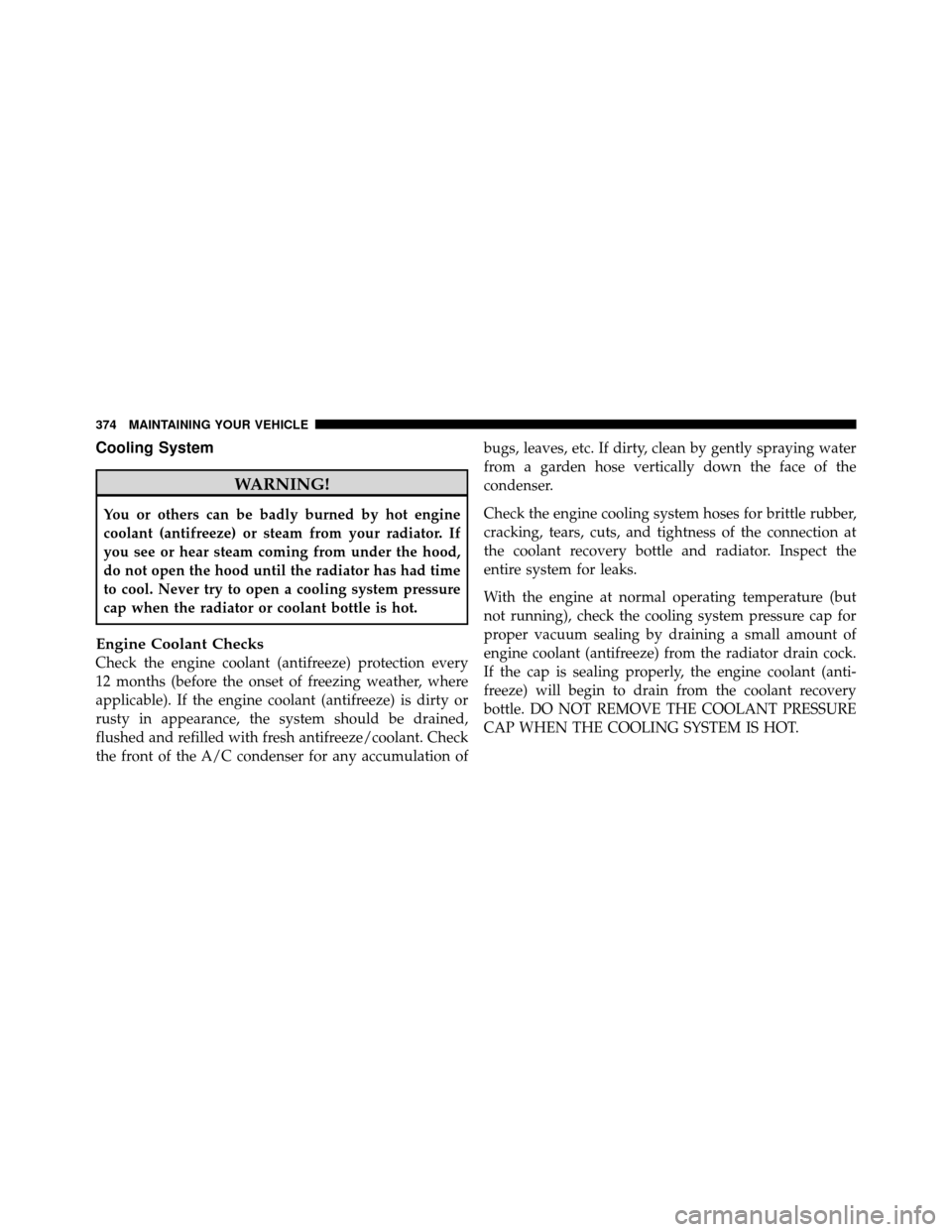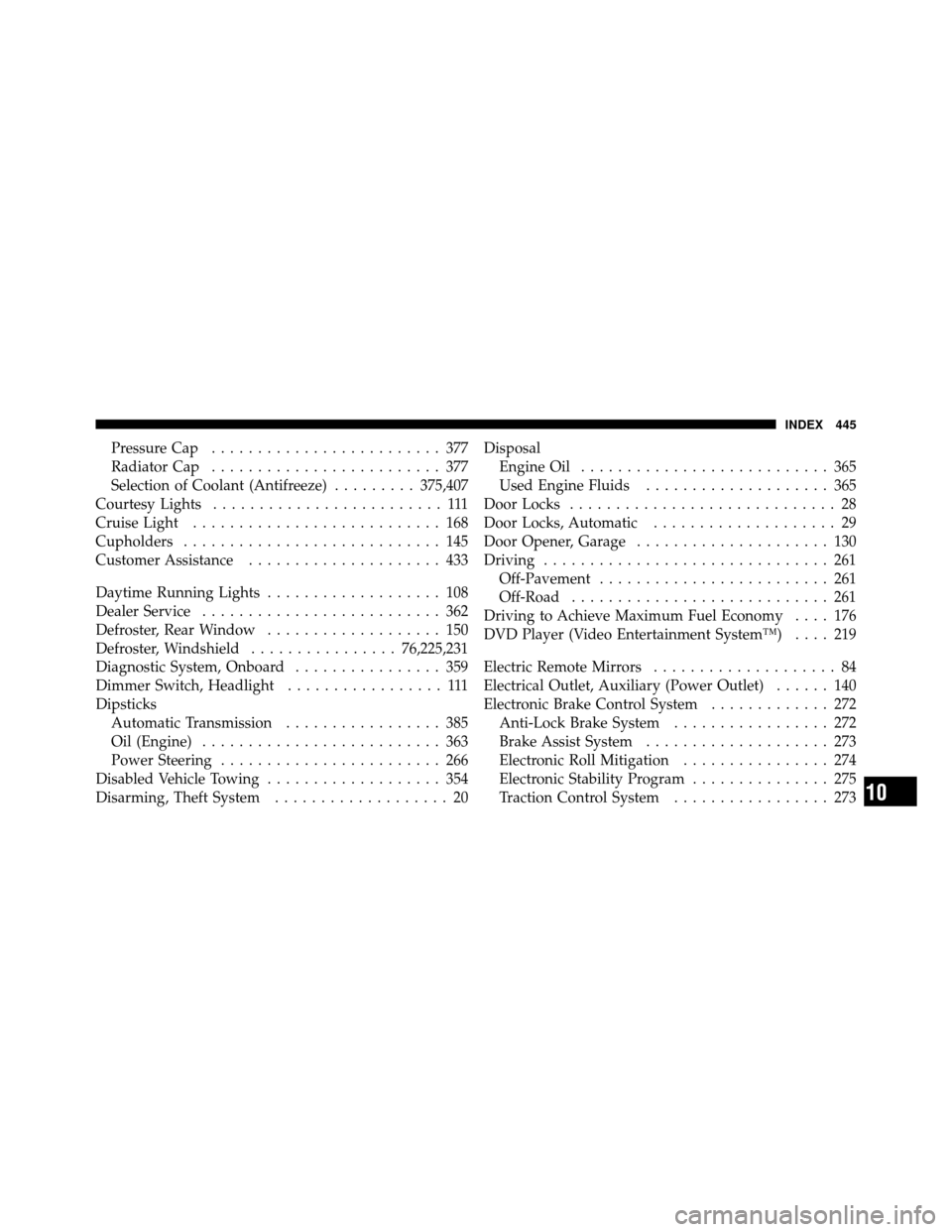radiator cap JEEP COMMANDER 2010 1.G Owners Manual
[x] Cancel search | Manufacturer: JEEP, Model Year: 2010, Model line: COMMANDER, Model: JEEP COMMANDER 2010 1.GPages: 460, PDF Size: 7.11 MB
Page 374 of 460

Cooling System
WARNING!
You or others can be badly burned by hot engine
coolant (antifreeze) or steam from your radiator. If
you see or hear steam coming from under the hood,
do not open the hood until the radiator has had time
to cool. Never try to open a cooling system pressure
cap when the radiator or coolant bottle is hot.
Engine Coolant Checks
Check the engine coolant (antifreeze) protection every
12 months (before the onset of freezing weather, where
applicable). If the engine coolant (antifreeze) is dirty or
rusty in appearance, the system should be drained,
flushed and refilled with fresh antifreeze/coolant. Check
the front of the A/C condenser for any accumulation ofbugs, leaves, etc. If dirty, clean by gently spraying water
from a garden hose vertically down the face of the
condenser.
Check the engine cooling system hoses for brittle rubber,
cracking, tears, cuts, and tightness of the connection at
the coolant recovery bottle and radiator. Inspect the
entire system for leaks.
With the engine at normal operating temperature (but
not running), check the cooling system pressure cap for
proper vacuum sealing by draining a small amount of
engine coolant (antifreeze) from the radiator drain cock.
If the cap is sealing properly, the engine coolant (anti-
freeze) will begin to drain from the coolant recovery
bottle. DO NOT REMOVE THE COOLANT PRESSURE
CAP WHEN THE COOLING SYSTEM IS HOT.
374 MAINTAINING YOUR VEHICLE
Page 377 of 460

Please note that it is the owner’s responsibility to main-
tain the proper level of protection against freezing ac-
cording to the temperatures occurring in the area where
the vehicle is operated.
NOTE:Mixing engine coolant (antifreeze) types will
decrease the life of the engine coolant (antifreeze) and
will require more frequent engine coolant (antifreeze)
changes.
Cooling System Pressure Cap
The cap must be fully tightened to prevent loss of engine
coolant (antifreeze), and to ensure that engine coolant
(antifreeze) will return to the radiator from the coolant
recovery tank.
The cap should be inspected and cleaned if there is any
accumulation of foreign material on the sealing surfaces.
WARNING!
•The warning words DO NOT OPEN HOT on the
cooling system pressure cap are a safety precau-
tion. Never add engine coolant (antifreeze) when
the engine is overheated. Do not loosen or remove
the cap to cool an overheated engine. Heat causes
pressure to build up in the cooling system. To
prevent scalding or injury, do not remove the
pressure cap while the system is hot or under
pressure.
•Do not use a pressure cap other than the one
specified for your vehicle. Personal injury or en-
gine damage may result.
Disposal of Used Engine Coolant
Used ethylene glycol-based engine coolant (antifreeze) is
a regulated substance requiring proper disposal. Check
with your local authorities to determine the disposal
7
MAINTAINING YOUR VEHICLE 377
Page 378 of 460

rules for your community. To prevent ingestion by ani-
mals and children, do not store ethylene glycol-based
engine coolant (antifreeze) in open containers or allow it
to remain in puddles on the ground. If ingested by a child
or pet, seek emergency assistance immediately. Clean up
any ground spills immediately.
Coolant Level
The coolant bottle provides a quick visual method for
determining that the engine coolant (antifreeze) level is
adequate. With the engine idling, and warm to normal
operating temperature, the level of the engine coolant
(antifreeze) in the bottle should be between the ranges
indicated on the bottle.
The radiator normally remains completely full, so there is
no need to remove the radiator cap, unless checking for
engine coolant (antifreeze) freeze point or replacing en-
gine coolant (antifreeze). Advise your service attendantof this. As long as the engine operating temperature is
satisfactory, the coolant bottle need only be checked once
a month.
When additional engine coolant (antifreeze) is needed to
maintain the proper level, it should be added to the
coolant bottle. Do not overfill.Points To Remember
NOTE:
When the vehicle is stopped after a few miles
(kilometers) of operation, you may observe vapor coming
from the front of the engine compartment. This is nor-
mally a result of moisture from rain, snow, or high
humidity accumulating on the radiator and being vapor-
ized when the thermostat opens, allowing hot engine
coolant (antifreeze) to enter the radiator.
If an examination of your engine compartment shows no
evidence of radiator or hose leaks, the vehicle may be
safely driven. The vapor will soon dissipate.
378 MAINTAINING YOUR VEHICLE
Page 443 of 460

Fluid Type........................... 383
Special Additives ...................... 383
Torque Converter ...................... 254
Autostick ............................. 250
Auxiliary Electrical Outlet (Power Outlet) ...... 140
Auxiliary Power Outlet ................... 140
Battery ............................... 367
Emergency Starting ..................... 351
Keyless Transmitter Replacement (RKE) ....... 24
Saving Feature (Protection) ............... 110
Belts, Seat ............................ 40,75
Body Mechanism Lubrication ............... 369
B-Pillar Location ........................ 290
Brake Assist System ...................... 273
Brake Control System, Electronic ............. 272
Brake Fluid ............................ 380
Brake System ........................... 379
Anti-Lock (ABS) .................... 269,272
Fluid Check .......................... 380 Master Cylinder
....................... 380
Parking ............................. 267
Warning Light ........................ 160
Brake/Transmission Interlock ............... 247
Break-In Recommendations, New Vehicle ........ 73
Bulb Replacement ..................... 400,401
Bulbs, Light ............................ 76
Calibration, Compass ..................... 179
Camera, Rear ........................... 128
Capacities, Fluid ........................ 407
Caps, Filler Fuel ............................... 318
Power Steering ........................ 266
Radiator (Coolant Pressure) ............... 377
Car Washes ............................ 387
Carbon Monoxide Warning ...............74,317
Cargo Area Features ...................... 147
Cargo Compartment ...................... 147
Luggage Carrier ....................... 150
10
INDEX 443
Page 445 of 460

Pressure Cap......................... 377
Radiator Cap ......................... 377
Selection of Coolant (Antifreeze) .........375,407
Courtesy Lights ......................... 111
Cruise Light ........................... 168
Cupholders ............................ 145
Customer Assistance ..................... 433
Daytime Running Lights ................... 108
Dealer Service .......................... 362
Defroster, Rear Window ................... 150
Defroster, Windshield ................76,225,231
Diagnostic System, Onboard ................ 359
Dimmer Switch, Headlight ................. 111
Dipsticks Automatic Transmission ................. 385
Oil (Engine) .......................... 363
Power Steering ........................ 266
Disabled Vehicle Towing ................... 354
Disarming, Theft System ................... 20 Disposal
Engine Oil ........................... 365
Used Engine Fluids .................... 365
Door Locks ............................. 28
Door Locks, Automatic .................... 29
Door Opener, Garage ..................... 130
Driving ............................... 261
Off-Pavement ......................... 261
Off-Road ............................ 261
Driving to Achieve Maximum Fuel Economy .... 176
DVD Player (Video Entertainment System™) .... 219
Electric Remote Mirrors .................... 84
Electrical Outlet, Auxiliary (Power Outlet) ...... 140
Electronic Brake Control System ............. 272
Anti-Lock Brake System ................. 272
Brake Assist System .................... 273
Electronic Roll Mitigation ................ 274
Electronic Stability Program ............... 275
Traction Control System ................. 273
10
INDEX 445